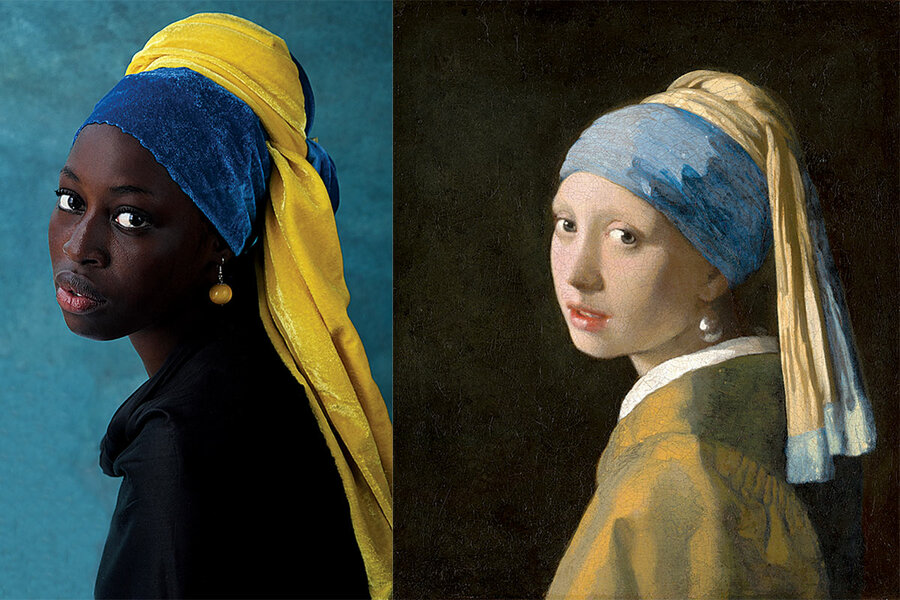With timeless masterpieces and modern riffs, Vermeer endures
Loading...
| AMSTERDAM
Quiet, calm, and order pervade the deep interior spaces of Johannes Vermeer’s paintings. Light pours in from windows, illuminating his subjects going about their daily tasks, heads bent over their work. Vermeer creates a sense of familiarity and comfort even for viewers today, some 350 years after his death.
“Vermeer,” a sold-out exhibition at the Rijksmuseum in Amsterdam running through early June, is a testament to his enormous, ongoing popularity. The show gathers 28 of an estimated 37 known paintings by the artist; it’s the first time this grouping has been seen together in one venue. Beyond a single exhibition, however, Vermeer’s work also influences a host of contemporary artists, who are riffing on, and engaging with, familiar Vermeer images such as “Girl With a Pearl Earring.”
Museumgoers today resonate with the intimate worlds Vermeer depicted, which provide small windows into 17th-century domestic life.
Why We Wrote This
A story focused onWhat qualities make art enduring? For museumgoers and modern artists, examining the work of 17th-century painter Johannes Vermeer offers the opportunity to both reflect on, and shift, the narrative.
“He created interiors that breathed tranquility,” says Taco Dibbits, general director of the Rijksmuseum, noting that at the time Vermeer was painting, the Netherlands was engaged in war with a number of countries. “Every brushstroke was a decision by him to create his ideal world. It’s his longing for peace and tranquility that we also feel nowadays. That’s what makes us love his work so much.”
The designers of the new exhibit had that feeling in mind, too: The paintings are given plenty of room to breathe. After experiencing the 10 galleries, viewers reflect on the appeal of the Dutch artist.
“I’m very drawn to how Vermeer works with natural light from the outside to illuminate a scene,” says Amsterdam resident Juliana Hesseling. “I also appreciate the fact that he depicts ordinary people, not clergy or nobility.”
Vermeer is known to have worked at a slow pace compared to his peers, producing no more than two or three paintings in a year, and an estimated 50 paintings over his 20-year career as an artist.
A majority of his subjects are women. But with little known about them, it’s left to viewers to imagine their backgrounds. That’s exactly what author Tracy Chevalier did when she penned the 1999 bestseller “Girl With a Pearl Earring.”
“I’ve written a whole book about the look the girl in the painting is giving us,” she says via email, “yet I still don’t know what she’s thinking!”
Art aficionados and creatives of all kinds say they are attracted to Vermeer’s intricately detailed compositions, which often leave the impression of a photograph. Included in the Rijksmuseum exhibit are “The Milkmaid,” “The Geographer,” and “Mistress and Maid.” Also on view is the recently restored “Girl Reading a Letter at an Open Window.”
“Vermeer’s paintings have a dignity that is not found in the works of his contemporaries, despite the thematic similarities,” Arthur Wheelock, senior advisor to the Leiden Collection in New York, writes in an email.
“Aside from the visual qualities of Vermeer’s work, part of his appeal lies undoubtedly in the mystery surrounding him,” adds Dr. Wheelock, who was previously a curator of northern baroque paintings at the National Gallery of Art in Washington and an art history professor. “We know little of Vermeer’s artistic training in Delft, and how he developed his unique style of painting.”
Often referred to as the Sphinx of Delft, Vermeer did not leave behind any letters, diaries, sketches, or drawings.
A few centuries later, Black artists have interpreted one of his most iconic works for a modern era – often to prompt discussion about representation and race. A 2007 painting by American portraitist Kehinde Wiley, “Cheick I,” features a Black man wearing a small earring and a baseball cap staring back at the viewer.
Ethiopia-born multimedia artist Awol Erizku, who now lives in the United States, is perhaps best known for his photos of celebrities like Beyoncé and Amanda Gorman. But his portfolio also includes a 2009 photograph of a young Black woman in a headscarf, titled “Girl With a Bamboo Earring.”
Emphasizing the role of Mr. Erizku’s work, Steven Nelson, dean of the Center for Advanced Study in the Visual Arts at the National Gallery of Art in Washington has commented, “These portraits, which force us to look at the work of the Old Masters through a black, diasporic lens, challenge Western art history’s almost blinding whiteness.”
The recent project “Noire Vermeer,” from Amsterdam-based artist Angèle Etoundi Essamba, has additional relevance, as this year marks 150 years since slavery fully ended in Dutch colonies. Ms. Essamba, who says she is fascinated with the “central place” Vermeer gave to women, has interpreted his famous painting into sculpture, a video installation, and a series of photographs called “Girl With an Amber Earring,” with Black women as the focus.
“With ‘Noire Vermeer,’ I’m showing a Black Woman who stares at us, free and self-confident,” writes the Cameroon-born artist in an email. “She claims her right to look, to be different, to shine, to exist.”
Also true of these contemporary works is something American novelist Katharine Weber appreciates in Vermeer paintings – that the gaze of the subjects often rests “on something we do not see.”
Ms. Weber, whose 1998 book “The Music Lesson” is inspired by Vermeer, writes via email that the artist “has opened these private moments of solitude to our view.”







